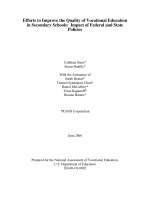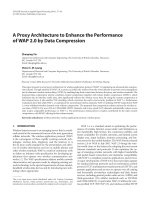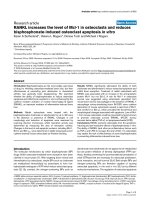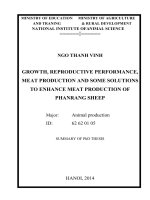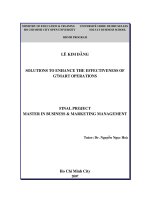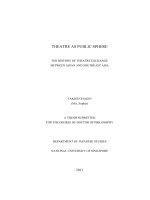Solutions to enhance the level of employee recognition in coca cola southeast asia
Bạn đang xem bản rút gọn của tài liệu. Xem và tải ngay bản đầy đủ của tài liệu tại đây (336.68 KB, 78 trang )
Ho Chi Minh City – Year 2015
UNIVERSITY OF ECONOMICS HO CHI MINH CITY
International School of Business
------------------------------
Nguyen Thi Thanh Tuyen
Solutions to Enhance the Level of
Employee Recognition in Coca-Cola
Southeast Asia
ID: 22130093
MASTER OF BUSINESS ADMINISTRATION
SUPERVISOR: Dr. Nguyen Thi Nguyet Que
Dr. Tran Ha Minh Quan
Table of contents
ACKNOWLEDGMENT....................................................................................................3
Executive Summary...........................................................................................................4
Chapter 1: Problem Identification......................................................................................5
1.1
Introduction of the company.................................................................................5
1.2
Background of the business problem....................................................................6
1.3
Justification of the problem existence................................................................. 11
1.4
Justification of the problem importance.............................................................. 15
1.5
Potential causes of the problem........................................................................... 18
Chapter 2: The alternative solutions................................................................................. 22
2.1
Justification of the potential causes..................................................................... 22
2.2
Proposed alternative solutions............................................................................. 26
Chapter 3: The Selected Solution..................................................................................... 33
3.1
Explanation for selected solutions....................................................................... 33
3.2
Change Plan........................................................................................................ 40
Chapter 4: Conclusion...................................................................................................... 47
Chapter 5: Supporting Information.................................................................................. 48
5.1
Supporting information of business problem background justification...............48
5.2
Supporting information of problem existence justification................................. 50
5.3
Supporting information of problem importance justification..............................56
5.4
Supporting information of potential causes......................................................... 57
5.5
Supporting information of potential causes justification..................................... 59
5.6
Supporting information of proposed solutions.................................................... 67
References........................................................................................................................ 69
1
List of Tables
Table 1: Turnover Rate Comparison from 2013-2015..................................................8
Table 2: Turnover Rate Comparison from 2013-2015 in Coca and Pepsi................177
Table 3: Employee performance in Q1 and Q2 at Coca-Cola and Pepsi..................188
Table 4: A comparison of alternative solutions........................................................333
Table 5: Action timeline and objectives...................................................................422
Table 6: Questionnaire items and references for problem existence justification.....511
Table 7: Interviewee’s Answers for problem justification........................................533
Table 8: Potential causes and definition...................................................................588
Table 9: Questionnaire items and references for potential cause justification
(employees).............................................................................................................600
Table 10: Employee’s answers for potential cause justification...............................611
Table 11: List of questions and answers in justifying the potential causes (manager).
655
List of Figures
Figure 1: Reasons for employees’ resignation in 2015............................................... 10
Figure 2: A cause-and-effect map of low employee recognition................................ 21
Figure 3: Final Cause –Effect Map............................................................................ 26
2
ACKNOWLEDGMENT
I am heartily thankful to my supervisors, Dr. Nguyen Thi Nguyet Que and Dr Tran
Ha Minh Quan, whose encouragement, guidance and support from the initial to the final
level enabled me to develop an understanding of problems, solutions and structure. At the
beginning of the thesis, I had met misunderstanding about the real problems, their
outcome and factors, Ms Que and Mr Quan instructed me to come over the difficulties,
helped me understand the thesis structures, and edited flaws. Therefore, I deeply
appreciate their contribution.
Lastly, I offer my regards and blessings to all my colleagues, friends and
classmates who supported me in any respect during the completion of the thesis.
3
Executive Summary
On October 2015, the author got the chance to talk to Coca-Cola’s General
Manager in their quarterly meeting, in which he raised some problems whom company
had to face. The employee’s turnover rate drastically increased, impacting to the business
and raising a large amount of recruitment cost in the company. To find out the real
problem of recognition and its causes, and draw the effective solutions for this issue, the
author closely works with human resource department and management team, besides,
make interviews with employees and heads of departments to deeply understand the
company situation and acquire their view points, combining interview data, literature
reviews, and company sources to buttress the argument.
This thesis includes five chapters, in each chapter; the author analyses collected
data, strengthens the argument by literature, and emphasizes the problem’s consequences
and real causes, and seeks for the effective solutions that are applicable to company
problems.
4
Chapter 1: Problem Identification
This chapter includes six sections. In the first section, the author makes
introduction that inform company’s general information. The following chapter
convincingly shows an interview data that the author makes with employer and human
resource manager to understand the basic background of the business problem. The third
and fourth sections are the justification of problem existence, and the justification of
problem importance, which clearly indicate the problem’s existence and its’ outcome.
Then, the author lists down the potential causes of the problem that closely bases the
literature in the fifth section. Finally, the cause and effect map exhibits the whole picture
of the correlation among potential causes, real problems and their outcome.
1.1 Introduction of the company
The representative office of Coca-Cola has been established in 1994 with
responsibilities: to act as a liaison office, conduct market surveys, carry out activities to
stimulate, and establish co-operation projects of Coca-Cola Southeast Asia, Inc. in
Vietnam, act as a communicative office, execute market research, and promotion
activities, and run the marketing campaign and stimulate the implementation of
contracts and agreements in the areas of commerce and investment signed between
Coca-Cola Southeast Asia, Inc. and Vietnamese Co-operations in compliance with
Vietnam Law leader in the beverage industry. As a global the Coca-Cola Company
offers hundreds of brands, including soft drinks, fruit juices, sports drink and other
5
beverage in Vietnam particularly and in more than two hundreds countries in general.
Coca-Cola is meeting the tastes of people around the globe.
In January 2015, the company runs the organizational restructuring to cut cost,
downsize the workforce and open new positions matching to each employee’s
capabilities. Besides, many unnecessary positions had been cut to ensure the long term
development, reaching to company vision. A haft of employees was abruptly
terminated in this period; some people were rotated to the new roles or to the new
working locations. After restructuring, there are thirty five employees (ten temporary
employees and twenty five permanent employees) under seven departments, including:
Human resource, Knowledge and Insights, Finance, Commercial and Operations,
Technical, PAC, and Marketing
1.2 Background of the business problem
In this step, the author applied qualitative method through interviews, and
collected data from human resource reports. Data resembled, analyzed and relied on the
answers whose interviewees are general manager and human resource manager (section
5.1 in supporting information chapter) and reports were provided from Human resource
department (table 1: turnover Rate comparison from 2013-2015, figure 1: reasons for
employees’ resignation in 2015) in this section.
In the quarterly meeting, the general manager announced the business
performance at Coca- Cola Vietnam in nine months in 2015 particularly and in three
years in general. He also raised the difficulties that company has met since January
6
2015. So, the author made an interview with him and human resource manager, who
deeply understand about company situation. The answers have been briefly described in
the section 5.1 of supporting information chapter. Firstly, the general manager was
asked about turnover rate, which had been stated as a main concern in his speaking.
General Manager confirmed that since 2014, crisis global economy in general and in
Vietnam in particular has attacked to business performance in Coca- Cola Vietnam,
many compensation packages have been cut to ensure the profit in each division
through the interview. For two years, the award and promotion have been limited.
Besides, after organizational restructuring, many positions have been cut, and many
employees’ job tasks have doubled, workload has been over. Many employees have
worked over time and under the pressure to ensure the project run smoothly and match
with project timeline. Many of them required to add more assistant positions, causing
the cost would be over budget for 2015. Therefore, General Manager had to reject the
request, making employees unhappy with his decision.
According to the Table of Turnover Rate Comparison that is provided from
Human Resource Department, the turnover rate increases 8%, comparing to in 2014,
increases 13.7%, comparing to 2013. So, the cost for recruitment process and training
courses for new employees strongly increased to 53,690 USD in 2015 (table 1). In the
office, the major of staffs in office who decided to quit their jobs are managers,
causing to the recruitment process always takes time to select the suitable candidates
7
and consequently this process impacts to the current employees who have to cover the
tasks whose staffs were already left.
Table 1: Turnover Rate Comparison from 2013-2015
Years
2013
2014
2015
Source: Human Resource Report in 2015 (Coca-Cola Southeast Asia)
According to the pie chart of potential reasons (figure 1), all former employees
who had been interviewed with human resource department before leaving, Human
Resource Manager stated that 45% of them feel devalued and unrecognized from their
managers. Because when the job got done, they did not get any compliments from their
manager, even they did not understand the difficulties that employees had been meeting
at. Some of employees assert that after so many years, they were not promoted because
of the lack of recognition and understanding from their managers. Moreover, the
conflicts partly rose from the way that their mangers gave feedback to their concern in
hard tasks. As the figure 1 shows in the pie chart of employees’ resignation reasons in
2015, there are more than 30% employees who left Coca-Cola because they got the
better job offers from other companies in the same industries, such as: Nestle, Dutch
8
lady, and Unilever. 17% interviewees implied that over workload is main reason for
resignation. Besides, headcount freeze is established to limit cost, so company cannot
offer the permanent positions to temporary employees who work for Coca-Cola more
than five years. So, temporary employees feel stress about their career paths when they
are not extended their contracts as permanent employees. They do not know whether
their contracts can be renewed when it expires, they can sign a new contract or not.
There are four reasons, such as: low employee recognition, over workload, other job
offers, and job security which are considered as problems in Coca-Cola. However,
there are limitation about timing and budget to plan for the solutions. In the interview
with Human resource department, more than 45% of employees confirmed that
recognition is the main reason pushing them to quit the job. The author, general
manager, and human resource manager discussed and decided low recognition is key
problem needs to be immediately solved to improve working spirit in the long term.
9
Figure 1: Reasons for employees’ resignation in 2015
Reasons for employees' resignation
in 2015
8%
Job offers
30%
17%
Recognition
Over workload
Job security
45%
Source: Human Resource Report in 2015 (Coca-Cola Southeast Asia)
To explain for the skeptical decision making, first of all, Klubnik (1994) said
that recognition also has the appeal of being appropriated for everyone in the companya tool that does not have to be expensive or flow through rigid corporate channels. The
low recognition can be solved immediately because it heavily impacts to the employee
turnover rate, the relationship and trust among employees and their supervisors. When
the relationship and trust have been negatively broken, they raise the conflict in the
organization and greatly reduce the employee’s productivity. In addition, there are so
many campaigns have been activated every year, requiring the cooperation in each
department. Therefore, the conflict may effect on the project progress and impact to the
business. The majority of former employees confirmed that they left the company
because of the low recognition from their manager. Secondly, to decrease workload or
10
increase job security, the process required the experts who deeply understand the
structures and function in each department. This process consumes time and cost, and
depends much on Headquarter policy in Atlanta and economic condition, and this
change can impact to Human Resource structure and interacted to the Legal department.
In another hand, the solutions that limit the employees from leaving by better job offers,
request a competitive Compensation and benefits system that need to be changed and
rewrote, should be approved to the CEO in headquarter. So, this plan is impossible if the
project should be completed in a year.
Hence, the General Manger, Human Resource and the author confirmed that the
recognition improvement is a key strategy that adequately solves the problem in the
short time with the acceptable cost and the plan can be nationally acted. However,
testing the existence of the problem in the company, the author made an interview with
employees. The data collected from their answers would be justified whether the
problem solely exists in the firm.
1.3 Justification of the problem existence
In this step, the author justifies whether low recognition is the real problem in
Coca-Cola. The author decides to make an interview that focuses on the recognition
assessment from current and former employees who are under different departments, job
grades and working experiences, or submitted termination letters, or who already left
company to deeper understand company’s current problems purposely. To understand
measurement scale of recognition, there are researches have been cited belows.
11
Hopkins (1995) define recognition is communication between management and
employees which rewards them for reaching specific goals or producing high quality
results in the workplace. Recognizing or honoring employees for this level of service is
meant to encourage repeat actions, through reinforcing the behavior would like see
repeated. The key is not necessarily what recognition is bestowed, but the fact that the
employee is being recognized. In organizations, employee recognition is one of the
motivational strategies that are gaining more and more attention from managers.
Employee recognition is typically conceptualized as the assignment of personal nonmonetary rewards to reinforce desired behaviors displayed by an employee. Feys,
Anseel & Wille (2013). There are two aspects to employee recognition. The first aspect
is to actually see, identify or realize an opportunity to praise someone, such as:
appreciation, motivation. The other aspect of employee recognition is, of course, the
physical act of doing something to acknowledge and praise people for their good work,
such as: promotion opportunities, benefits.
According to Henryhand (2009) and Kopelman, Richard, Gardberg & Brandwein
(2011) research, the author develops interview questions and the answers that are briefly
showed in the section 5.2. The answer data will be confidentially recorded to make sure
all answers are not biased and are straightforward. There are eight interviewees who are
current and former employees in different departments, job grades, and working
experiences to insure that all data are collected, are diversified and accurately reflect
substance of the problem.
12
1.4 Data analysis
Benefits
Four over eight employees answers that their salary has not competitive after the
restructuring when their tasks have been doubled. The result indicated that employees
are still not happy with the company benefits. The answers are showed in table 7 (the
section 5.2).
Job promotion opportunities
The finance and procurement assistant shared that her contribution was not
recognized and she had not promoted, although she works for 5 years. There are three
of eight employees confirmed that they have not promoted for many years, and poorly
asserted that they total unhappy with the promotion system at Coca-Cola, because their
job grade should be upgraded for their contributions that they contribute to company
for many years. The finance and procurement assistant shared “The promotion chance
is unfair when it just evaluates employees who have good academic records from
university, and do not qualified people who had more experiences and good job
performance”. The collected data informed that there is the lack of promotion chances
in the company. The answers are showed in table 7 (section 5.2)
13
Motivation
According to the answers, 50% employees think that their bosses recognize and
motivate their jobs, five over eight interviewees stated that they did not get the timely
compliments or motivation from manager, although they got the job well done. For
example: Commercial and operations manager said that “my manager did not give my
any support and motivation for my new position. He rejected all my ideas that change
the way to work effectively, so I decide to quit the job”. And another one emphasizes
that his boss does not give the feedback because his boss think that they need to be
proactive in the job obstacles that they met. Therefore, the author can conclude that
many employees do not received the feedback and support from their managers. The
answers are showed in table 7 (the section 5.2).
Appreciation
The author asked about the appreciation that employees realize. Five of eight
interviewees said that they did not felt appreciated when they work in Coca-Cola. For
instance: Finance and Procurement assistant said: “I feel unhappy and appreciation in
my contribution, and do not know about the next year when my contract will be expired,
whether I can continue working here. She think that she contribute to company for
many years. And then she is assign to be a temporary staff” in table 7 (section 5.2). The
result from data indicated that a majority of interviewees feel that they are not
appreciated for what they contributed to the company.
14
Combining the General Manager and Human Resource Manager’s ideas and
primary data throughout interview, the author asserts that low employee recognition
is a main problem happening in Coca-Cola Southeast Asia. In the next step, the
author determines the problem’s importance.
1.4 Justification of the problem importance
Firstly, the author searches for the impact of recognition to employee turnover
rate in the literature to emphasize and support for the conclusion. Saunderson (2004)
also stated employee recognition is still seen as an important part in helping to retain
employees in an ever-changing job marketplace. Managers and leaders in the public
sector strongly believe in the importance of giving meaningful employee recognition
correlating with good morale, loyalty and commitment in the workplace. The more
recognition employees get from their job, the more they want to be loyalty to the
company. Skudiene, Everhart, Slepikaite & Reardon (2013) presented that a lack of
recognition is one of the main reasons why a good employee quits the job.
Muthuveloo, Basbous, Ping & Long (2013) shared that People like to be acknowledged
for their exceptional offerings and contribution. Interestingly, even though a lot of
organizations offer formal rewards and recognition programs for employee ideas and
contributions, many employees are still ambitious for more day-to-day informal
recognition. Employees who sense they are listened to, supported and recognized for
their contributions are expected to be more engaged. He also indicated that the lack of
employee appreciation plays a serious role in employees' decisions to quit the job and
15
leave their organizations. According to literatures and the actual consequences from
Turnover Rate Comparison table from 2013-2015 (table 1), the table shows that the
turnover rate in 2015 is more 8% than in 2014 and 13 % than in 2013. The turnover rate
rapidly increases through three years. Besides, manager turnover rate steeply rises in
2015 and reach at the peak in three years with 82% as mentioned in the section 1.2. In
addition, the author makes the research about the turnover rate at the competitor; the
record shows that there is disproportionate rate between Coca-Cola and Pepsi. CocaCola’s rate gets 12% higher than Pepsi’s rate in 2015 (table 2) and the distance is
constantly farther than previous years. This negative change faithfully reflects the
consequences of the problems that effect to the turnover rate in Coca-Cola. If People are
recognized, they tend to commit their career path the company. In the contrast, if they
feel that their contribution is not appreciated or is disregarded, they toward to look for
another better place to contribute. In the short term, it impacts company’s revenue,
while it has to spend more money to recruit the new employees taking time to learn new
things and adapt themselves to the new cultures. In the long term, it impacts to the profit
and employee development. The cost for the recruitment in 2015 reached at 53,690
USD as the result turnover rate increase. Therefore, the recognition substantially
influences the turnover rates in Coca-Cola with itself consequences that need to be
precisely evaluated and primarily solved.
16
Table 2: Turnover Rate Comparison from 2013-2015 in Coca and Pepsi
Source: Human Resource Report in 2015 (Coca-Cola, Suntory Pepsico)
Secondly, Mone, Eisinger, Guggenheim, Price & Stine (2011) show that
recognition can be viewed as a form of feedback rooted in positive reinforcement and tied
to an employee’s behavior or accomplishment of a specific goal or task, research shows
that recognition links to employee performance and company success. However, if
employees are not recognized for their efforts, they could experience mental and emotional
distress and burnout. He also assures that an important component of the performance
management process is the effective use of recognition system and providing ongoing
feedback to employees, improving performance. To clarify this judgment is happening in
the company, the author analyzes the performance records of employees in two quarters in
2015. They were made every three months to evaluate the employee performance. The
records show that there is decrease in objective completion in Quarter 1, while the
competitors get the higher rate at 81% in Quarter 1 and 72% in Quarter 2. There are
significant differences between two companies in the beverage industry. This case shows
that the employee performance in Coca-Cola is lower than
17
employee performance in Pepsi through two first quarters in 2015. Combining the
literature support and records from Human Resource in Coca-Cola Company and Pepsi
Company, the author can finalize that recognition relates to the turnover rate and
employee performance in the Coca-Cola.
Table 3: Employee performance in Q1 and Q2 at Coca-Cola and Pepsi
Quarter
Q1
Q2
Source: Human Resource Report in 2015 (Coca-Cola Southeast Asia)
From the analyses, the author confirms that recognition significantly effect to
the turnover rate and employees performance. To find out the appropriate solutions, the
author continues to find the causes that influence the recognition by literature supports
and employee interview.
1.5 Potential causes of the problem
In this step, the author finds the potential causes that impact on the recognition.
Potential causes are listed down with the literature supports that focus on information that
related to causes that should be clearly considered.
According to Özutku (2012), rewards were defined to include all types of
compensation, from cash payments to working conditions. Organizations offer intrinsic
18
and extrinsic reward to members for the purpose of improving human resources
outcomes. An intrinsic reward is a sense of achievement, or a conscious satisfaction.
An extrinsic reward is an award that is tangible or physically given to you for
accomplishing something. Rustand (2001) also stated that rewards (incentive awards,
performance awards) may be available through the human resources department and
should be used to show employees how much they are appreciated and he concluded
that there is a statistically significant relationship between reward and recognition
respectively.
Baker, Perreault, Reid & Blanchard (2013) defined formal or informal feedbacks
as a dynamic communication process occurring between two individuals that convey
information regarding the receiver's performance in the accomplishment of workrelated tasks and make them feel recognized. Feedback is used to provide information
on proximal goals and immediate and recent behaviors. It is also utilized to inform
members of desirable development and outcomes. Lorenzet, Cook & Cynthia Ozeki
(2006) research that the strategies use for providing feedback to employee and for
creating action plans to increase the likelihood that the recognition level changes will
become permanent. They also concluded effective feedback with the end of result
increased employee recognition.
Masvaure, Ruggunan, & Maharaj (2014) defined intrinsic motivation refers
to motivation that comes from inside an individual rather than from any external or
outside rewards. It drives an individual to adopt or change a behavior for his or her
19
own internal satisfaction or fulfillment. Intrinsic motivation is usually self-applied,
and springs from a direct relationship between the Individual and the situation.
According to Dar, Bashir, Ghazanfar & Abrar (2014) indicated that intrinsic
motivation has positive influence on employee recognition.
Koning & John (1993) stated that benefits are applied to all employees and are
included as part of the employment package. They are particularly useful in
employee recognition. Benefits include: health care, vacation, sick leave, child care,
scholarship funds, elder care, fitness facilities, and various types of insurance. There
is a positive relationship between benefits and employee recognition.
Pergamit & Veum (1999) defined promotions involved no change in position or
duties, but were simply an upgrade of the current position. A promotion is the "prize,"
and the probability of winning it is a function of productivity. The winner of the prize
receives the salary and prestige associated with the higher position Consequences of
promotion included increased wages, training receipt, supervisory responsibilities, and
increased level of employee recognition
According to the literature reviews, we have five factors relate to the
recognition, including: rewards, feedback, intrinsic motivation, benefits and
promotions. In addition, basing on the above research about the real problem and
their impact, the cause- effect map is presented as bellows:
20
Rewards
Rustand (2001) and Özutku, H.
(2012)
Feedback
Baker, Perreault, Reid &
Blanchard (2013)
High employee turnover rate
Skudiene, V., Everhart, D.
D.,
Intrinsic Motivation
Slepikaite, K., & Reardon, J.
(2013)
Masva
K
Perga
Figure 2: A cause-and-effect map of low employee recognition
21
Chapter 2: The alternative solutions
In this chapter, the author made an interview with the employees to fully grasp the
causes that exist at Coca-Cola. After collecting and analyzing data, the author searches
for the solutions from literature and replies on the requirements from the company to
propose the suitable solutions to the existing problem.
2.1 Justification of the potential causes
After listing the potential causes from the literatures (table 8 in section 5.4), the
author made an in depth interview with twenty current and former employees from
different departments and job levels to find the potential factors impact to the recognition.
Before asking, the author clearly explain the definition of each potential causes to help
employees understand the term of each causes, giving the useful answers for the analysis.
The questions are developed on the research of Kopelman, Richard, Gardberg &
Brandwein (2011). The questions focus on the interviewees’ answers that related to what
are the key factors in the list of five potential causes, which are selected from literature
reviews, fifteen employees answered that the timely feedback and reward from their
managers have impacted to recognition.
Feedback
Admin assistant said that: “support and feedback make employees aware whether we
are recognized”. Or “timely and motivated feedbacks play important role in making us feel
appreciated”. Some people confirmed that the feedback from direct managers and
22
their support impact to employees’ performance and commitment. Employees appreciate
balance and fairness. Interview results have showed that useful feedback inspire
employees to work hard and play an important role in recognizing employees ’
performance. For instances: the Commercial and Operations assistant answered when the
author asked them why she think that feedback is real cause of the problems “My former
manager always assign the hard tasks for me. He even did not support me to complete it.
So I think that support and feedback make employee aware whether our contribution is
highly appraised”. The feedback and support also help them to clear the mess, and
overcome the problems to work smoothly. Brand manager assistant claimed that she had
feel disappointed about her jobs because, she did not get the prompt support from her
manager when she asked for help – “the feedback come late, or even my manager did
not give any feedbacks. I feel very disappointed; the feeling makes me confused about
what I should do when I got stuck in the mess. So I think that timely and motivated
feedback plays important role in making us defeat the trouble”. 80% employees
admitted that the feedback from their manager is crucial factor that impacts to
recognition.
Rewards
Besides, eleven employees agreed that reward is essential factor “reward is the gift
that I get after the efforts. It shows that all my contributions have been company
recognized”- Management trainee answered. Some employees who work for so long time
and their job becomes routine. Rewards are an effective way wake them up and refresh
themselves. In addition, Office manager asserted: “for the long time, we have tried our
